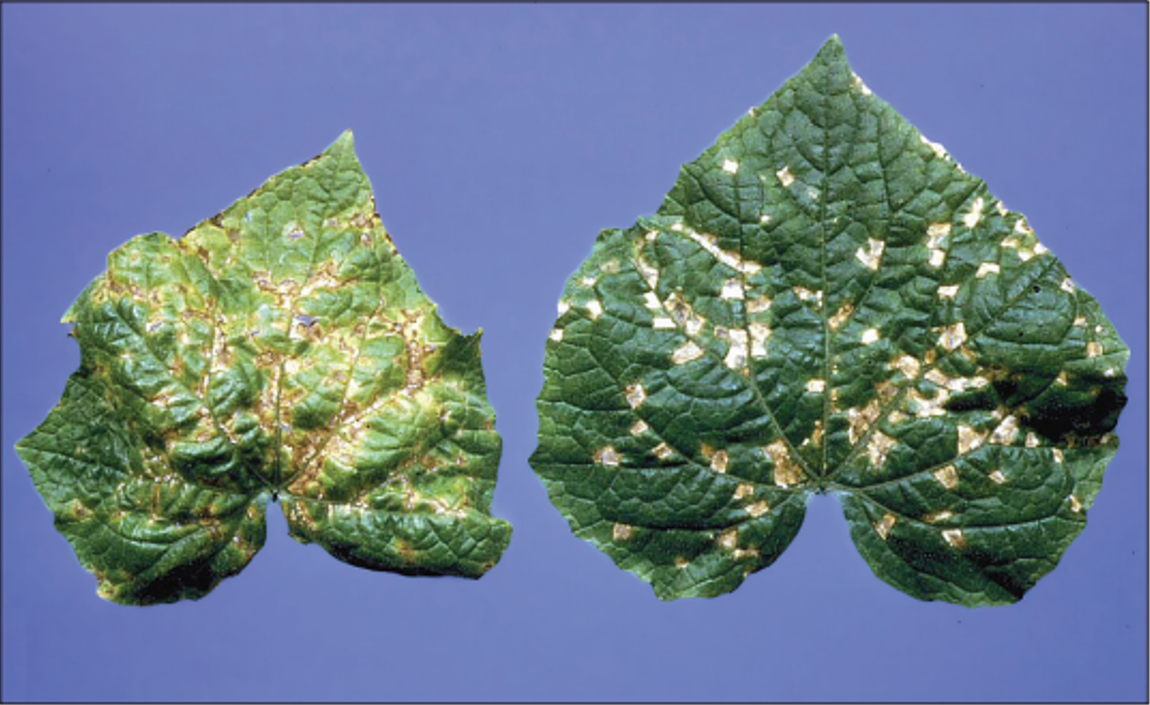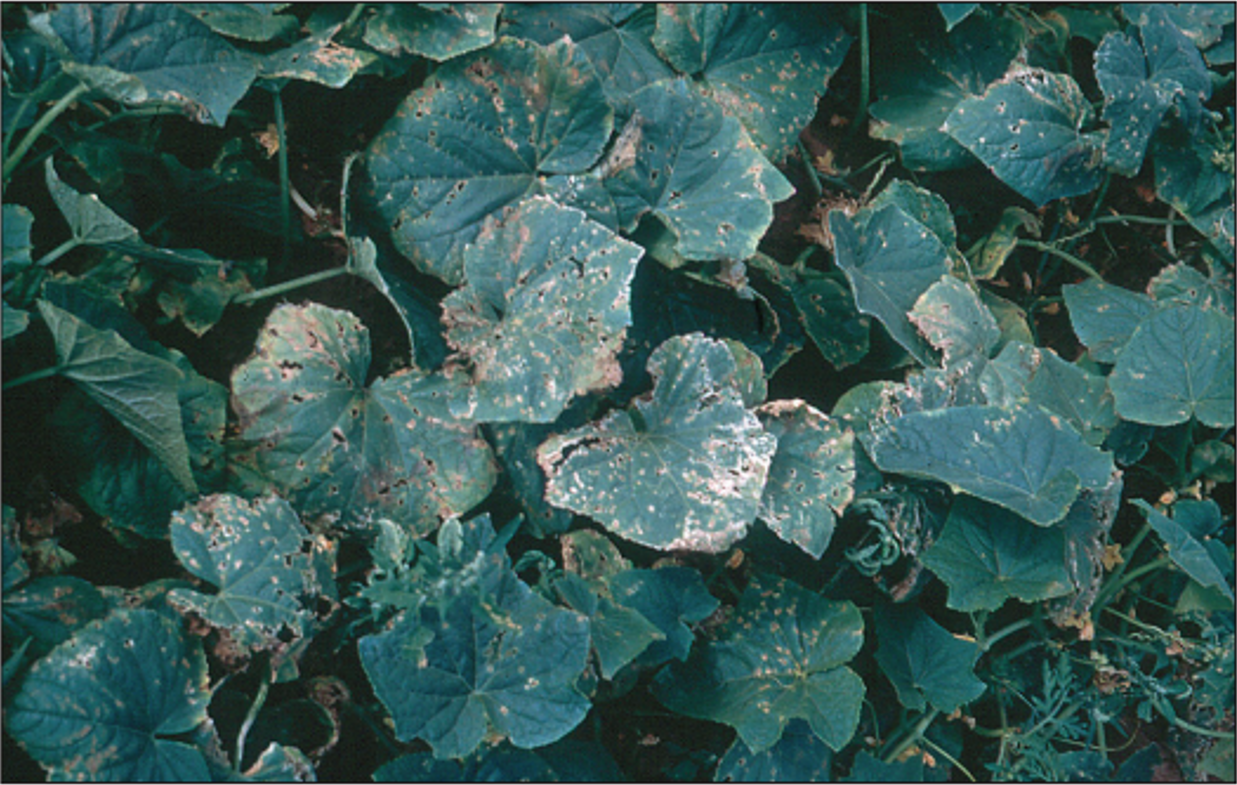
In This Issue:
- Vegetable production updates
- Disease forecasting updates for potato early blight and late blight
- Cucurbit downy mildew updates
- Angular leaf spot of cucurbits
Yi Wang, Associate Professor & Extension Potato and Vegetable Production Specialist, UW-Madison, Dept. of Plant and Agroecosystem Sciences, 608-265-4781, Email: wang52@wisc.edu.
According to the Wisconsin Agriculture Weather Outlook, the past 30 days remain wetter-than-normal from several storms. Last week was cooler-than-normal, with lows dipping into the upper 30s and low 40s on August 25-26. This is a change from what has been warmer than normal in the last 30 days.
Precipitation for the next 7 days is predicted to be highest in the north, which chances statewide for measurable rainfall amount. Climate probabilities for early September show a strong trend towards below-normal temperatures for most parts of the state (50-60% chance). However, the outlook for the month of September and for the fall season (September – November) show a trend slightly towards above normal temperatures.
Reported by some potato growers, only about a quarter of total acreage has been harvested so far. Yield and quality looks close to average, but it is very early to conclude an overall yearly number yet. Some fields that suffered from almost 4’’ of heavy rainfall between August 16th and 18th showed higher percentage of green tubers (i.e., heavy intense precip carried away soil from the hill and tubers were exposed to the sunlight that caused accumulation of chlorophylls) which are not marketable.
For snap beans, yields have been a little up and down, but also near average. More white mold has been seen recently, due to the wet rainy period in mid-August, but not too severe. Growers and processors started to see a fair bit of brown spot around the Plainfield/Hancock area recently. Overall, harvest is behind based on calendar, but stays on top of pod maturity.
Some folks have questions about potential effects of smoke from wildfires on potato yield and quality. According to a recent study published by researchers at the University of Idaho that used three russet potato varieties (including Russet Burbank) as the research materials and built small plastic tunnels filled with smoke for the treatment, no visual symptoms were noted, nor did plants senesce earlier compared to the no-smoke treatment. The smoke treatment led to a decreased percentage of US No. 1 yields and slightly increased percentage of culls. The following-up economic analysis detected variable crop returns from a 20% decrease to a 17% increase between the three varieties and across the two study years in comparison to the no-smoke control. The conclusion is that no clear effect of smoke was found on potato growth and production.
Amanda Gevens, Professor & Extension Vegetable Pathologist, UW-Madison, Dept. of Plant Pathology, 608-575-3029, gevens@wisc.edu, Lab Website: https://vegpath.plantpath.wisc.edu/.
Current P-Day (Early Blight) and Disease Severity Value (Late Blight) Accumulations will be posted at our website and available in the weekly newsletters. Thanks to Ben Bradford, UW-Madison Entomology for supporting this effort and providing a summary reference table: https://agweather.cals.wisc.edu/thermal-models/potato. A Potato Physiological Day or P-Day value of ≥300 indicates the threshold for early blight risk and triggers preventative fungicide application. A Disease Severity Value or DSV of ≥18 indicates the threshold for late blight risk and triggers preventative fungicide application. Data from the modeling source: https://agweather.cals.wisc.edu/vdifn are used to generate these risk values in the table below. I’ve estimated early, mid-, and late planting dates by region based on communications with stakeholders. These are intended to help in determining optimum times for preventative fungicide applications to limit early and late blight in Wisconsin.
|
|
Planting Date | 50% Emergence Date | Disease Severity Values (DSVs)
through 8/30/2025 |
Potato Physiological Days (P-Days)
through 8/30/2025 |
|
| Spring Green | Early | Apr 5 | May 10 | 64 | 896 |
| Mid | Apr 18 | May 14 | 64 | 868 | |
| Late | May 12 | May 26 | 61 | 811 | |
| Arlington | Early | Apr 5 | May 10 | 46 | 898 |
| Mid | Apr 20 | May 15 | 46 | 860 | |
| Late | May 10 | May 24 | 43 | 824 | |
| Grand Marsh | Early | Apr 7 | May 11 | 66 | 873 |
| Mid | Apr 17 | May 14 | 66 | 853 | |
| Late | May 12 | May 27 | 66 | 799 | |
| Hancock | Early | Apr 10 | May 15 | 64 | 839 |
| Mid | Apr 22 | May 21 | 64 | 813 | |
| Late | May 14 | June 2 | 64 | 758 | |
| Plover | Early | Apr 14 | May 18 | 49 | 813 |
| Mid | Apr 24 | May 22 | 49 | 806 | |
| Late | May 19 | June 7 | 49 | 712 | |
| Antigo | Early | May 1 | May 24 | 56 | 758 |
| Mid | May 15 | June 1 | 56 | 723 | |
| Late | June 1 | June 15 | 51 | 638 | |
| Rhinelander | Early | May 7 | May 25 | 38 | 741 |
| Mid | May 18 | June 8 | 38 | 663 | |
| Late | June 2 | June 16 | 34 | 623 | |
Late blight of potato/tomato. I’m aware of no new reports of late blight in the US this past week. Findings thus far in potato and tomato have been confirmed as US-23 Phytophthora infestans (still sensitive to mefenoxam/metalaxyl (ie: Ridomil). Here in Wisconsin, we saw limited accumulations of 0-5 DSVs across WI this past week. All plantings of potatoes in Wisconsin have surpassed the Blitecast threshold of 18 DSVs and should receive preventative fungicides for the management of late blight. Please find a fungicide listing for Wisconsin potato late blight management: https://vegpath.plantpath.wisc.edu/documents/potato-late-blight-fungicides/
Early blight of potato. Accumulations of P-Days were 28-52 over the past week, with P-Day 300 thresholds met for preventative fungicide treatment in potatoes across all of Wisconsin. Some fields are moving through the harvest process at this point. Remaining fields are showing a big transition in overall foliar quality this past week. In the final day/weeks of the crop it becomes difficult to discern advanced early blight from other diseases including potato early dying, brown spot, and/or blackleg/aerial stem blight. https://vegpath.plantpath.wisc.edu/diseases/potato-early-blight/. For Wisconsin-specific fungicide information, please refer to the Commercial Vegetable Production in Wisconsin (A3422), a guide available here: https://cropsandsoils.extension.wisc.edu/articles/2025-commercial-vegetable-production-in-wisconsin-a3422/
For custom values, please explore the UW Vegetable Disease and Insect Forecasting Network tool for P-Days and DSVs across the state (https://agweather.cals.wisc.edu/vdifn). This tool utilizes NOAA weather data. Be sure to enter your model selections and parameters, then hit the blue submit button at the bottom of the parameter boxes. Once thresholds are met for risk of early blight and/or late blight, fungicides are recommended for optimum disease control. Fungicide details can be found in the 2025 Commercial Veg. Production in WI Extension Document A3422: https://cropsandsoils.extension.wisc.edu/articles/2025-commercial-vegetable-production-in-wisconsin-a3422/
Cucurbit Downy Mildew: No downy mildew was seen on cucurbits this past week at HARS, and none reported through our UW Plant Disease Diagnostic Clinic. The basil downy mildew that I reported on July 27 at Hancock ARS has not advanced from the lower plant canopies. The downy mildew work of Dr. Mary Hausbeck at Michigan State University is relevant to WI https://veggies.msu.edu/downy-mildew-news/. This season, Clade 2 downy mildew spores were confirmed in several MI counties and downy mildew has been confirmed in commercial cucumber fields and home garden plots in several MI counties. A new report in PA was reported this paste week at the Cucurbit Downy Mildew ipm PIPE website: https://cdm.ipmpipe.org/.
Angular leaf spot of cucurbits has been commonly diagnosed in Wisconsin over the past few weeks. This disease looks somewhat like downy mildew, but is caused by a bacterial pathogen Pseudomonas syringae pv. lachrimans. Angular leaf spot is a bacterial disease that can be economically damaging to leaves, stems, and fruit of cucumbers, honeydew melon, and zucchini squash growers in Wisconsin. Initial lesions appear as small, tan, water-soaked spots that are delineated by the veins of the leaf giving the ’angled’ or straight edge appearance of lesions on the leaves. As the lesions expand and develop, they typically turn white and papery in texture until the dead tissue falls out of the leaf, leaving a hole and often a tattered appearance to the leaf. Under humid conditions, a milky substance (bacterial ooze) may be notes on the infected foliage. This ooze dries to a white crust around the lesions. While fruit may appear healthy during leaf infection, the infection may continue to develop later in the season or post harvest as the lesions develop into soft areas of fruit under the cuticle or skin.
The pathogen may be seedborne or debris-borne (for up to 2 years). To manage this disease, reduce the likelihood of infection by rotating out of cucurbit crops for at least 2 years and use disease free seed. In greenhouse cucumbers, lowering the humidity to 80-90% will help reduce the spread of the disease. Hot water and chemical seed treatments are not effective for totally eliminating the pathogen on infested seed (pathogen is beneath the seed coat). Breeding efforts have resulted in a large selection of cucurbits with tolerance to angular leaf spot. In some cultivars, tolerance to the disease is most strongly expressed in the fruit while significant infection can still occur in the foliage during cool, wet weather. Pictures of leaf lesions, below, and elements of this disease summary courtesy of Emeritus Professor Walter Stevenson, and Karen Delahaut of UW-Plant Pathology.


Prolonged leaf wetness favors infection. The bacterium enters the leaf through respiration pores (stomates), water excreting pores (hydathodes), or wounds. Infections spread from leaf to leaf by splashing rain, human activity, and cucumber beetles.
Copper containing fungicides can limit plant to plant spread of this disease. Treatments must be made every 5-7 days when the pressure is high and fruit require further expansion and maturity.